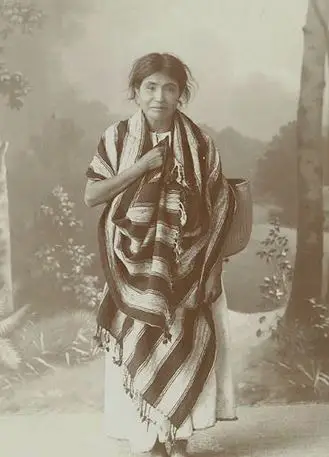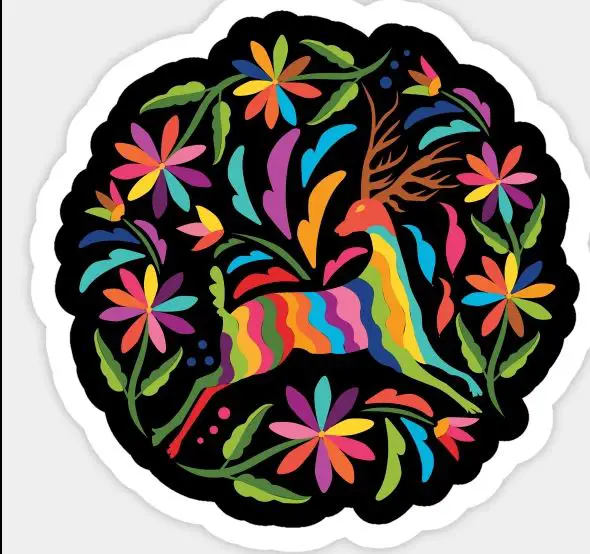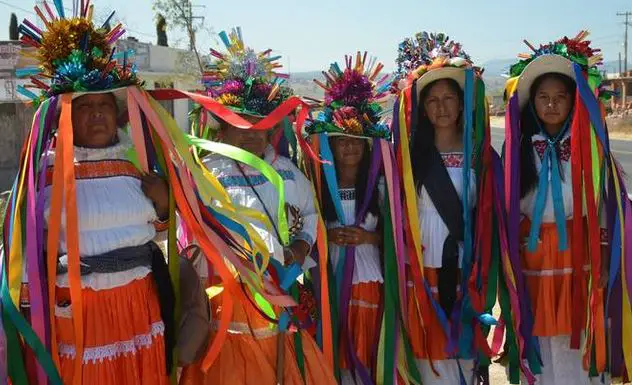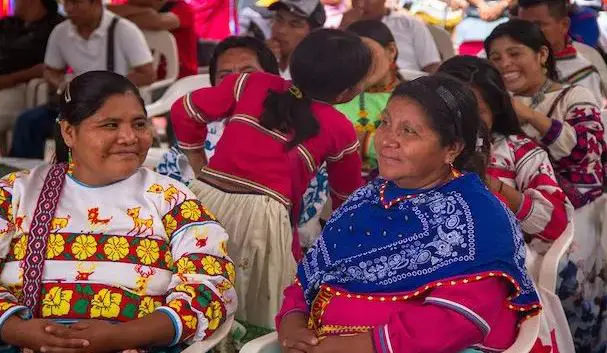Podcast: Play in new window | Download
Subscribe: Apple Podcasts | RSS
 The Otomí are one of the most ignored and marginalized indigenous groups in Mexico. Today this resilient people lives fragmented across what used to be a vast homeland which included the fertile valleys and high mountains in the central part of Mexico, extending north into the altiplano and east all the way into the modern-day state of Veracruz. Although bound by culture and blood, because of their living in isolation and being cut off from one another for so many years, the Otomí speak a variety of dialects, either 4 or 5 depending on which linguist you speak to. Not many people, even in the Mexico of today, know much about the Otomí. Less is known about their history. Some researchers believe that the ancestors of the modern-day Otomí were the ones who built the great city of Teotihuacán. Many also believe that the Otomí’s ancestors were the Toltecs with their capital at Tula, which the Otomí of today call Mähñem’ì. In any event, they were living in a series of peaceful kingdoms in the Valley of Mexico at the time of the arrival of the Aztecs in the early 1300s. To employ a modern, overly used academic term, The Aztec “colonizers” took over the Otomí territory and adopted some elements of their culture. This is why some words in Nahuatl, the language of the Aztec Empire, are found in no other Uto-Aztecan language, because they came from the languages of the people already living in the area when the Aztecs arrived. Researchers believe that the Aztecs also incorporated some of the older Otomí gods into their own pantheon. An example is Otontecuhtli which literally means “the Otomí lord,” who is an old and powerful fire god who watches over the earth to bring order to things when necessary. Although they were a conquered people, the Aztecs had great respect for the Otomí, and even went so far as to name an elite fighting force within their own superior military after the Otomí, called the Otontín. Although the Otomí people have suffered under the Aztecs, the Spanish and the Mexican government, and have endured everything from attempted annihilation, forced assimilation and multiple involuntary relocation efforts, the Otomí culture survives intact today. Community-based language revival efforts are reversing the trend of falling numbers of native speakers of the Otomí dialects, and with now close to 300,000 speakers of these dialects, this element of culture appears to be thriving in modern times. Among the other elements of Otomí culture that have survived into the 21st Century include many legends. Here are four.
The Otomí are one of the most ignored and marginalized indigenous groups in Mexico. Today this resilient people lives fragmented across what used to be a vast homeland which included the fertile valleys and high mountains in the central part of Mexico, extending north into the altiplano and east all the way into the modern-day state of Veracruz. Although bound by culture and blood, because of their living in isolation and being cut off from one another for so many years, the Otomí speak a variety of dialects, either 4 or 5 depending on which linguist you speak to. Not many people, even in the Mexico of today, know much about the Otomí. Less is known about their history. Some researchers believe that the ancestors of the modern-day Otomí were the ones who built the great city of Teotihuacán. Many also believe that the Otomí’s ancestors were the Toltecs with their capital at Tula, which the Otomí of today call Mähñem’ì. In any event, they were living in a series of peaceful kingdoms in the Valley of Mexico at the time of the arrival of the Aztecs in the early 1300s. To employ a modern, overly used academic term, The Aztec “colonizers” took over the Otomí territory and adopted some elements of their culture. This is why some words in Nahuatl, the language of the Aztec Empire, are found in no other Uto-Aztecan language, because they came from the languages of the people already living in the area when the Aztecs arrived. Researchers believe that the Aztecs also incorporated some of the older Otomí gods into their own pantheon. An example is Otontecuhtli which literally means “the Otomí lord,” who is an old and powerful fire god who watches over the earth to bring order to things when necessary. Although they were a conquered people, the Aztecs had great respect for the Otomí, and even went so far as to name an elite fighting force within their own superior military after the Otomí, called the Otontín. Although the Otomí people have suffered under the Aztecs, the Spanish and the Mexican government, and have endured everything from attempted annihilation, forced assimilation and multiple involuntary relocation efforts, the Otomí culture survives intact today. Community-based language revival efforts are reversing the trend of falling numbers of native speakers of the Otomí dialects, and with now close to 300,000 speakers of these dialects, this element of culture appears to be thriving in modern times. Among the other elements of Otomí culture that have survived into the 21st Century include many legends. Here are four.
- The Coyote in the Otomí Creation Story
Because modern Otomí people have evolved cut off from one another, and true to form of many myths and legends from different Mesoamerican peoples, there are several different stories about the creation of the universe. The following was part of the creation myth as told by the Otomí people living in the central Mexican state of México, and can also be found in Otomí communities in the states of Michoacán and Querétaro.
 In the beginning of time, the “Creative Parents,” called Ts’ita Ka and Ts’inana, existed and they cast into form all people, animals and everything else in the universe. This heavenly mother and heavenly father are associated at times with the moon and the sun, respectively. When the animals were created, the heavenly father gave them documents made from bark paper that told each animal what they could eat and what role they would play on earth. The coyote, called ‘uee, was assigned to eat people. The heavenly mother, Ts’inana, did not want the coyote to eat her earthly children, so she tried to come up with a way to prevent the coyote from eating people. Ts’inana decided to build a small stand to sell the alcoholic drink pulque at a crossroads where she knew the coyote would travel. When the coyote saw the pulque stand, he asked for a drink and the heavenly mother was happy to oblige. After a few gourdfuls of the intoxicating beverage, the coyote got so drunk that he wandered away and passed out. While he was unconscious, the heavenly mother took the paper document out of the coyote’s small backpack and burned it. The next morning the coyote returned to the pulque stand with questions for Ts’inana, the heavenly mother.
In the beginning of time, the “Creative Parents,” called Ts’ita Ka and Ts’inana, existed and they cast into form all people, animals and everything else in the universe. This heavenly mother and heavenly father are associated at times with the moon and the sun, respectively. When the animals were created, the heavenly father gave them documents made from bark paper that told each animal what they could eat and what role they would play on earth. The coyote, called ‘uee, was assigned to eat people. The heavenly mother, Ts’inana, did not want the coyote to eat her earthly children, so she tried to come up with a way to prevent the coyote from eating people. Ts’inana decided to build a small stand to sell the alcoholic drink pulque at a crossroads where she knew the coyote would travel. When the coyote saw the pulque stand, he asked for a drink and the heavenly mother was happy to oblige. After a few gourdfuls of the intoxicating beverage, the coyote got so drunk that he wandered away and passed out. While he was unconscious, the heavenly mother took the paper document out of the coyote’s small backpack and burned it. The next morning the coyote returned to the pulque stand with questions for Ts’inana, the heavenly mother.
The coyote said, “Hey lady, did I leave something behind here? I am very sad and very hungry. I lost my document, and I don’t know what to eat.”
“No, Mister Coyote,” the heavenly mother said, “I don’t have your document.”
“But lady,” the coyote said, “I am hungry, and I don’t know what to eat.”
From there, the heavenly mother looked for a way to prevent the desperate coyote from eating her children. She gave him various tests:
“Go bite that stone,” she ordered him.
The coyote went to do what the woman told him but returned to her and said: “I couldn’t, the stone is hard.”
Then she told him again, “Go bite that tree.”
When he couldn’t, she then said to him, “Go chase those sheep that pass by there. You choose the biggest one.” The coyote wanted to catch the youngest, but he couldn’t because a big dog came out and chased him.
Very discouraged, he returned to Ts’inana, the heavenly mother, and replied: “Hey lady, I’m back, I couldn’t catch him, the dog chased me. What I do? I have nothing to eat! I am very hungry.” And then the coyote began to cry sadly.
Ts’inana tried again and said, “Go catch those turkeys that are out there. If you can grab them, that’s what you’re going to eat.” The coyote went to chase the turkeys and managed to catch up with them, plucked them and sat down to eat. Once his hunger was satisfied, he returned very happy to tell the lady: “Now I’ve eaten, I’m satisfied! Thank you!”. That is why now coyotes eat turkeys. In this way the men were saved from being devoured by ‘uee, the coyote. Had the heavenly mother not intervened, humanity would have become extinct.
- Where did Pulque Come from?
The alcoholic drink mentioned in the previous fable has long been an important part of life in Mesoamerica. We discuss pulque in detail in Mexico Unexplained episode number 182 https://mexicounexplained.com/pulque-drink-of-the-gods/ Some anthropologists believe that the Otomí were the ones who first brewed pulque in ancient Mexico and the Otomí people tell of this  drink’s origins through legend. The legend starts at the ancient city of Mähñem’ì, known today as the former Toltec capital of Tula. Ten years after King Tecpancaltzin occupied the throne at Mähñem’ì, he was visited by an Otomí nobleman by the name of Lord Papantzin and his lovely daughter Xóchitl. The lord presented to the king a sweet syrup and sugar produced by the maguey plant. The king was impressed by these gifts and was instantly taken by the beautiful Xóchitl. The king told Lord Papantzin that he would love to receive these gifts again, but he was to send young Xóchitl alone to deliver the syrup and sugar. Lord Papantzin obeyed his king and, in a few weeks, sent his daughter to the king’s palace to deliver the gifts. King Tecpancaltzin took the young woman to a fortress several miles away and kept her there under guard. The king would make frequent visits to the fortress and soon Xóchitl became pregnant. She gave birth to a son, whose name would be Meconetzin, which meant, “Son of the Maguey.” Together with the goddess of the maguey plant, Xóchitl’s son was said to have invented pulque, but this was the official story from the king. It was really Lord Papantzin who made the discovery, but the king wanted to hide the information from his people, not wanting to give the credit to his lowly father-in-law.
drink’s origins through legend. The legend starts at the ancient city of Mähñem’ì, known today as the former Toltec capital of Tula. Ten years after King Tecpancaltzin occupied the throne at Mähñem’ì, he was visited by an Otomí nobleman by the name of Lord Papantzin and his lovely daughter Xóchitl. The lord presented to the king a sweet syrup and sugar produced by the maguey plant. The king was impressed by these gifts and was instantly taken by the beautiful Xóchitl. The king told Lord Papantzin that he would love to receive these gifts again, but he was to send young Xóchitl alone to deliver the syrup and sugar. Lord Papantzin obeyed his king and, in a few weeks, sent his daughter to the king’s palace to deliver the gifts. King Tecpancaltzin took the young woman to a fortress several miles away and kept her there under guard. The king would make frequent visits to the fortress and soon Xóchitl became pregnant. She gave birth to a son, whose name would be Meconetzin, which meant, “Son of the Maguey.” Together with the goddess of the maguey plant, Xóchitl’s son was said to have invented pulque, but this was the official story from the king. It was really Lord Papantzin who made the discovery, but the king wanted to hide the information from his people, not wanting to give the credit to his lowly father-in-law.
- Why the Forest has so Many Trees
In this brief legend the Otomí tell the story behind a popular embroidery seen in many markets where the indigenous still sell their traditional crafts in central Mexico. The embroidery, usually made from red or purple thread, has a deer in its center with branches and leaves coming out of its head, taking up the entire panel of the embroidery. Legend has it that one day a very old deer with large antlers was walking through the forest with a very young deer. Back in those days deer could talk to each other, so the old deer started to explain things about the forest to the younger one. In that time the forest did not have too much vegetation. The lessons the old deer imparted to the young deer had to do with what we in the modern world would call conservation and respect for the environment. At the end of the long speech, the old deer fell to his knees and leaves started to sprout from his antlers. The young deer stood in astonishment as the antlers grew into tree branches and then he watched vines grow along the branches. The branches turned into thick tree trunks which sprouted even more branches covered in leaves. Soon, the forest became thick with vegetation. The old deer disappeared, sacrificing his life so that the forest could be more abundant.
- How the Sun and Corn were Made
 Many, many generations ago, the whole world was ruled over by a malevolent god called Zithu. Zithu had many evil ones, what modern people would call “demons,” doing his bidding for him on the earth. One day, these demons were tormenting a young boy for kicks and they chased him around, laughing at him, trying to get him. The boy did everything to try to hide from Zithu’s henchmen. After a few days of this, when the boy was looking for somewhere to hide, he was shot with an arrow. The demons rejoiced, but wanted to move on to tormenting other people, so they asked a rooster to watch over the wounded boy so he wouldn’t try to get away while they were away causing more mischief. If the boy tried to escape, the rooster was instructed to crow, so the demons could return and then decide what to do with the boy. On the fourth day, the rooster crowed, but the boy had recovered so well from the arrow wound that he ran far away until he found a gigantic tree. He climbed the tree all the way to the sky. The gigantic tree started to shed drops, and those drops turned into seeds. The seeds grew rapidly into cornstalks. By the time the demons of Zithu arrived on the scene, the boy had jumped into the sky from the top of the tree and became the sun. The demons could do nothing. The boy was seen as a hero, and because of what he did people now have abundant food, and the world enjoys the life-giving warmth of the sun.
Many, many generations ago, the whole world was ruled over by a malevolent god called Zithu. Zithu had many evil ones, what modern people would call “demons,” doing his bidding for him on the earth. One day, these demons were tormenting a young boy for kicks and they chased him around, laughing at him, trying to get him. The boy did everything to try to hide from Zithu’s henchmen. After a few days of this, when the boy was looking for somewhere to hide, he was shot with an arrow. The demons rejoiced, but wanted to move on to tormenting other people, so they asked a rooster to watch over the wounded boy so he wouldn’t try to get away while they were away causing more mischief. If the boy tried to escape, the rooster was instructed to crow, so the demons could return and then decide what to do with the boy. On the fourth day, the rooster crowed, but the boy had recovered so well from the arrow wound that he ran far away until he found a gigantic tree. He climbed the tree all the way to the sky. The gigantic tree started to shed drops, and those drops turned into seeds. The seeds grew rapidly into cornstalks. By the time the demons of Zithu arrived on the scene, the boy had jumped into the sky from the top of the tree and became the sun. The demons could do nothing. The boy was seen as a hero, and because of what he did people now have abundant food, and the world enjoys the life-giving warmth of the sun.
REFERENCES
Bernard, H.Russell and Jesus Salinas Pedraza. Otomi Parables, Folktales and Jokes. Chicago: University of Chicago Pres, 1976. We are Amazon affiliates. Buy the book on Amazon here: https://amzn.to/3C1RrwD

2 thoughts on “Legends of the Otomí People”
Can you direct me to any Otomi tribal representatives located in the United States?
Sorry, I don’t think they exist. The whole concept of “tribe” is different down there.